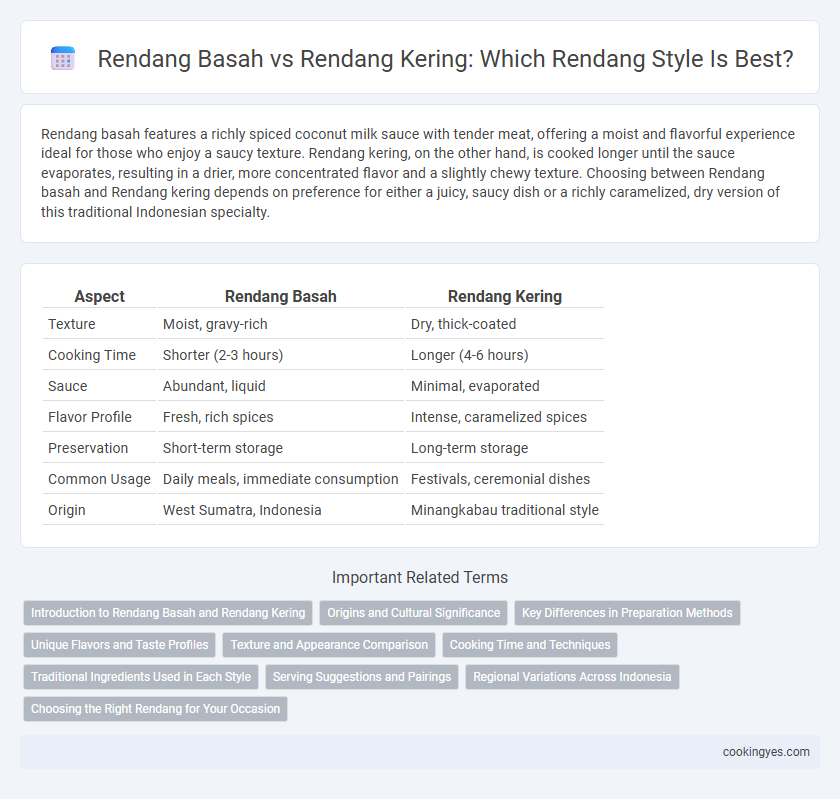Rendang basah features a richly spiced coconut milk sauce with tender meat, offering a moist and flavorful experience ideal for those who enjoy a saucy texture. Rendang kering, on the other hand, is cooked longer until the sauce evaporates, resulting in a drier, more concentrated flavor and a slightly chewy texture. Choosing between Rendang basah and Rendang kering depends on preference for either a juicy, saucy dish or a richly caramelized, dry version of this traditional Indonesian specialty.
Table of Comparison
| Aspect | Rendang Basah | Rendang Kering |
|---|---|---|
| Texture | Moist, gravy-rich | Dry, thick-coated |
| Cooking Time | Shorter (2-3 hours) | Longer (4-6 hours) |
| Sauce | Abundant, liquid | Minimal, evaporated |
| Flavor Profile | Fresh, rich spices | Intense, caramelized spices |
| Preservation | Short-term storage | Long-term storage |
| Common Usage | Daily meals, immediate consumption | Festivals, ceremonial dishes |
| Origin | West Sumatra, Indonesia | Minangkabau traditional style |
Introduction to Rendang Basah and Rendang Kering
Rendang Basah is a moist, saucy version of the traditional Indonesian dish, characterized by a shorter cooking time that retains more gravy and a softer texture. Rendang Kering undergoes a longer, slower cooking process resulting in a dry, caramelized exterior with intensified flavors and a chewier consistency. These two styles highlight the versatility of rendang, balancing moisture levels and flavor concentration according to regional and culinary preferences.
Origins and Cultural Significance
Rendang Basah and Rendang Kering originate from the Minangkabau ethnic group in West Sumatra, Indonesia, reflecting deep-rooted cultural traditions. Rendang Basah, known as wet rendang, is cooked for a shorter time, preserving a moist texture and vibrant spices, often served during everyday meals and communal gatherings. Rendang Kering, or dry rendang, undergoes a prolonged cooking process, resulting in a rich, caramelized flavor and longer shelf life, symbolizing celebration and respect during important ceremonies and festivals.
Key Differences in Preparation Methods
Rendang Basah is characterized by its moist, saucy texture achieved through a shorter cooking time and continuous liquid retention, preserving the rich, coconut milk-based gravy. Rendang Kering involves prolonged simmering, allowing the liquid to evaporate completely, resulting in a drier, caramelized exterior that intensifies the blend of spices and flavors. The key difference lies in moisture content and cooking duration, impacting texture and flavor concentration significantly.
Unique Flavors and Taste Profiles
Rendang Basah delivers a rich, coconut milk-infused flavor with tender, juicy meat that absorbs spices deeply, creating a creamy and aromatic taste profile. Rendang Kering offers a drier, caramelized texture where the meat is cooked longer until the sauce evaporates, intensifying the savory, slightly sweet, and smoky flavors. Both styles showcase the signature blend of galangal, lemongrass, and chili, but Rendang Kering emphasizes a concentrated, robust spiciness, while Rendang Basah highlights smooth, mellow richness.
Texture and Appearance Comparison
Rendang Basah features a moist, tender texture with a rich, saucy appearance that retains a glossy, dark brown gravy, highlighting the slow-cooked coconut milk and spice blend. Rendang Kering is characterized by a drier, more crumbly texture and a deeper, caramelized dark color, as the cooking process evaporates most of the liquid, intensifying flavors and creating a slightly crispy exterior. The contrast in texture and appearance between Rendang Basah and Rendang Kering reflects different regional preferences and cooking techniques, emphasizing either saucy richness or concentrated dryness.
Cooking Time and Techniques
Rendang Basah features a shorter cooking time, typically around 1-2 hours, resulting in a moist, saucy texture achieved through simmering the beef in coconut milk and spices until tender. Rendang Kering requires extended cooking, often 3-4 hours, as the liquid reduces and evaporates entirely, producing a dry, caramelized meat with intensified flavors through slow frying and continuous stirring. These distinct techniques influence the moisture content and flavor concentration, defining the classic rendang styles in Indonesian cuisine.
Traditional Ingredients Used in Each Style
Rendang Basah features a rich, coconut milk-based sauce with traditional ingredients like galangal, lemongrass, turmeric, and fresh chili, creating a moist and flavorful curry. Rendang Kering, distinguished by its drier texture, incorporates the same aromatic spices but involves longer cooking time for the coconut milk to dry out, intensifying the meat's infused taste. Both styles rely on traditional Indonesian herbs such as kaffir lime leaves and coriander seeds, ensuring authentic rendang flavor profiles.
Serving Suggestions and Pairings
Rendang Basah, characterized by its moist and tender texture, pairs exceptionally well with steamed white rice or ketupat, allowing the rich coconut and spice flavors to meld perfectly. Rendang Kering's drier and more concentrated form is ideal as a side dish or topping for nasi lemak, enhancing the savory and aromatic profile of the meal. Both styles complement fresh vegetable sides like acar pickles or sauteed greens, balancing the intense spices and providing a harmonious dining experience.
Regional Variations Across Indonesia
Rendang Basah, known for its moist and tender texture, is predominantly found in West Sumatra, reflecting the region's preference for slow-cooked, juicy rendang varieties. Rendang Kering, characterized by its drier and more caramelized finish, is popular in Riau and other parts of Sumatra, showcasing a style that emphasizes longer cooking times to intensify flavors and preserve the dish. These regional variations highlight the adaptability of rendang across Indonesia, with each area tailoring the dish to local tastes and cultural traditions.
Choosing the Right Rendang for Your Occasion
Rendang basah features a rich, saucy texture ideal for festive gatherings where the dish can be served immediately to preserve its creamy coconut-based gravy. Rendang kering, with its drier and caramelized coconut milk reduction, offers a longer shelf life and intense, concentrated flavors perfect for travel or as a gift during special occasions. Selecting the right type depends on the event's timing and presentation needs, with basah suited for fresh consumption and kering favored for portability and extended enjoyment.
Rendang Basah vs Rendang Kering for Rendang style Infographic

 cookingyes.com
cookingyes.com